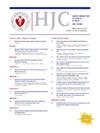Pre-procedural Stratification by the Endothelial Function in Patients with Heart Failure Undergoing Atrial Fibrillation Ablation
IF 3
3区 医学
Q2 CARDIAC & CARDIOVASCULAR SYSTEMS
引用次数: 0
Abstract
Background
Endothelial dysfunction (ED), a well-established risk marker of cardiovascular events, is associated with heart failure (HF) and atrial fibrillation (AF). Its relationship with cardiovascular events in patients with HF undergoing AF ablation remains unclear. We aimed to elucidate the association between ED and the outcomes after AF ablation in patients with HF.
Methods
This prospective cohort study included patients with HF who underwent an endothelial function assessment using the peripheral vascular reactive hyperemia index (RHI) before first-time AF ablation. We defined AF recurrence according to the following types: the conventional form (AF≥30 seconds) and persistent form (requiring cardioversion). An RHI<2.1 indicated ED. Those with and without ED were compared in terms of the 3-year incidence of AF recurrence and cardiovascular events after AF ablation.
Results
Among 421 patients with HF (69 ± 9 years and 38% females), 343 (81.5%) had ED. Although the incidence of the conventional form of AF recurrence was similar between the groups, that of the persistent form was significantly higher in the ED group (25.7% vs. 15.3%, log-rank P = 0.028). The ED group also had a significantly higher rate of cardiovascular events (14.8% vs. 3.6%, log-rank P = 0.028). Pre-procedural ED was identified as an independent predictor of a persistent form of AF recurrence (adjusted hazard ratio [HR] 2.31, 95% confidence interval [CI] 1.05–5.07, P = 0.037) and that of cardiovascular events (adjusted HR 4.21, 95% CI 1.02–17.5, P = 0.048), respectively.
Conclusions
The endothelial function assessment enabled the risk stratification of clinically problematic outcomes after AF ablation in patients with HF.

根据内皮功能对接受心房颤动消融术的心力衰竭患者进行术前分层。
背景:内皮功能障碍(ED)是心血管事件的公认风险指标,与心力衰竭(HF)和心房颤动(AF)有关。在接受房颤消融术的高血压患者中,ED与心血管事件的关系仍不明确。我们旨在阐明 ED 与接受房颤消融术的高血压患者房颤消融术后的结果之间的关系:这项前瞻性队列研究纳入了在首次房颤消融术前使用外周血管反应性充血指数(RHI)进行内皮功能评估的房颤患者。我们根据以下类型定义房颤复发:常规形式(房颤≥30 秒)和持续形式(需要心脏复律)。结果:在 421 名房颤患者(69±9 岁,女性占 38%)中,343 人(81.5%)患有房颤。虽然两组常规房颤复发率相似,但 ED 组的持续性房颤复发率明显更高(25.7% 对 15.3%,对数秩 P=0.028)。ED 组的心血管事件发生率也明显更高(14.8% 对 3.6%,对数秩 P=0.028)。术前ED被确定为房颤持续复发(调整后危险比[HR]2.31,95%置信区间[CI]1.06-5.06,P=0.035)和心血管事件(调整后危险比4.26,95%置信区间[CI]1.03-17.7,P=0.028)的独立预测因素:内皮功能评估有助于对心房颤动患者房颤消融术后的临床问题结果进行风险分层。
本文章由计算机程序翻译,如有差异,请以英文原文为准。
求助全文
约1分钟内获得全文
求助全文
来源期刊

Hellenic Journal of Cardiology
CARDIAC & CARDIOVASCULAR SYSTEMS-
CiteScore
4.90
自引率
7.30%
发文量
86
审稿时长
56 days
期刊介绍:
The Hellenic Journal of Cardiology (International Edition, ISSN 1109-9666) is the official journal of the Hellenic Society of Cardiology and aims to publish high-quality articles on all aspects of cardiovascular medicine. A primary goal is to publish in each issue a number of original articles related to clinical and basic research. Many of these will be accompanied by invited editorial comments.
Hot topics, such as molecular cardiology, and innovative cardiac imaging and electrophysiological mapping techniques, will appear frequently in the journal in the form of invited expert articles or special reports. The Editorial Committee also attaches great importance to subjects related to continuing medical education, the implementation of guidelines and cost effectiveness in cardiology.
 求助内容:
求助内容: 应助结果提醒方式:
应助结果提醒方式:


